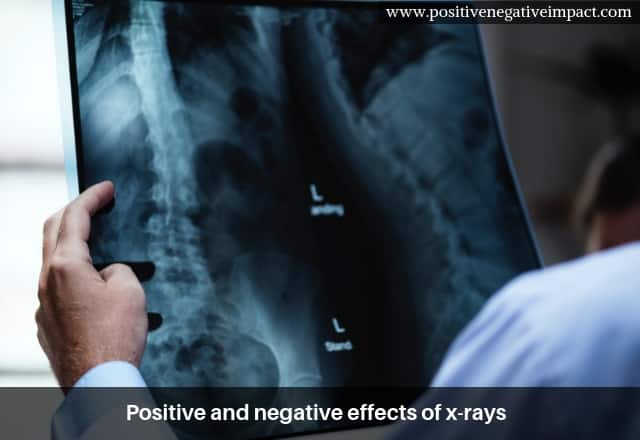X-rays are a vital imaging tool that has been in use for over the last hundred years and has proved itself to be a vital diagnostic tool by imaging people’s bones and helping doctors save countless lives in the process. Given the importance of this diagnostic tool, it is vital that you take a closer look at this machine and understand some of its positive and negative effects. Primarily, they are a naturally occurring source of electromagnetic radiation and doctor’s use films to image them, when these high energy particles collide with the patient’s bones and muscular structure.

Positive effects of x-rays:
- Diagnostic tool: As mentioned earlier, x-rays are mainly used as a diagnostic tool and are often used in various branches most effectively. They are used to capture images of limbs to determine if there is a fracture; similarly, they are also used to determine dental decay, the onset of pneumonia and much more. In fact, thanks to x-rays, doctors, in general, have been able to make an effective diagnosis that ended up saving the patient’s life.
- Fractures: X-rays are quite effective in determining if a person’s limb is fractured; a simple imaging does the trick and thanks to various advancements in the field of x-rays, doctors can now obtain a 3D image of the same which results in a better diagnosis.
- Tumours: X-rays can also help determine if a patient has a tumour or not; on determining the presence of a tumour, doctors can provide the patient with some immediate succour, relief and effective treatment, provided the x-ray managed to catch a tumour in its initial stages.
- Cost: X-rays do not cost much, at least not in comparison to other medical procedures. As a result, patients from various walks of life can get an x-ray done which can result in better diagnosis and improve the quality of their health in the process.
Negative effects of x-rays:
- Cancer: X-rays are a form of electromagnetic radiation and can pass through the body and some of the other objects as well. So, an exposure to a high dosage of x-rays can damage the cells in your body and can even cause tumours. Ironically, the same x-rays are used as a diagnostic tool to diagnose and treat tumours in patients.
- Changes to DNA: An exposure to a high dosage of x-rays can even mutate your DNA. This is one of the reasons why only low dosages of x-rays are used for diagnostics, but even so, depending on the medical procedure and the imaging performed, the risks of developing cancer and having the cells in your body damaged permanently remains high. It should be pointed out that even as both WHO and US government have declared x-rays to be carcinogenic, the dosages used in most medical procedures are extremely low, at best.
- Bones absorb radiation: It is not a well-known fact but x-rays are often absorbed by the bones in your body. As a result, you may develop calcium deficiency over time. Constant exposure to x-rays can cause you to develop brittle bones which can break over time. It is not a question of ‘if’ but rather one of ‘when’.
- Radiation sickness: Depending on how much you were exposed to, you may develop radiation sickness as a result of exposure to x-rays. This can result in you exhibiting various symptoms such as hair falling, diarrhoea, skin rashes, changes to DNA, mutations and even cancer.
- Dry mouth: One of the side effects of being exposed to x-rays happens to a case of dry mouth. If you just had your head examined with x-rays, then chances are high that you would develop a case of dry mouth and may even have trouble swallowing.
These are some of the positive and negative effects of x-rays; it Is true that your bones will absorb the radiation and regular exposure to the same will cause them to become brittle over time. And your DNA may even mutate and you may even develop cancer but that being said, the benefits far outweigh the risks associated with x-rays. Thanks to the various advancements made in medical science, especially in x-rays, doctors can now evaluate their patients by reviewing their x-rays in 3D. This allows them to check out the patient in more detail and enables them to review some of the underlying health conditions and to treat them for the same. It is indeed as good as it gets, if not more.
- Tulip Mania – The Story of One of History’s Worst Financial Bubbles - May 15, 2022
- The True Story of Rapunzel - February 22, 2022
- The Blue Fugates: A Kentucky Family Born with Blue Skin - August 17, 2021
